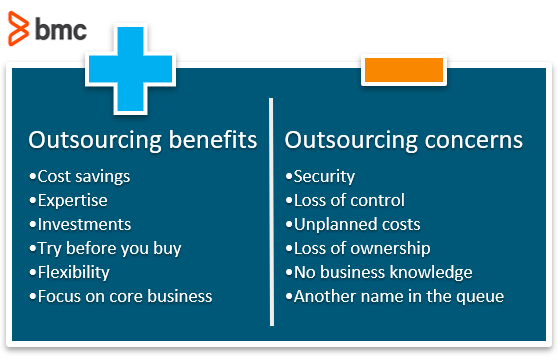The arguments for and against outsourcing the IT services consumed by an organization are many and varied.
One thing to remember is that there is no ‘one size fits all’ in this picture. Chances are that most businesses will need to outsource at least a subset of services that have very specialized platform or support requirements. But just how far to go in shedding the responsibility for hosting, managing, and supporting IT services is a very individual decision.
In this article, I consider a number of the pros and cons of outsourcing your IT services.
Insourcing or outsourcing: all or nothing?
Your particular reasons for making this decision will not be the same as another organization. You may be looking at financial, resourcing, expertise, or any number of other considerations. It is most likely that the best option is going to be a hybrid approach with some services supported within the organization and some through third party vendors.
As with any service management approach, you adopt and adapt to suit your individual requirements.

Benefits of outsourcing IT services
Let’s look firstly at some of the benefits of outsourcing:
Cost savings
More often than not, the driver for moving to managed services is cost. There can be considerable cost benefits derived from divesting the organization of expensive tech resources whose expertise may only be required occasionally.
One oft-overlooked benefit is that outsourcing removes the costs of staff turnover, holiday and sick leave, and other downtime periods that arise when working with in-house resourcing.
Likewise, sharing complex technology platforms can provide significant savings to the business. Infrastructure as a service (IaaS), Software as a Service (SaaS), telecommunications as a service (TaaS), and other offerings can all provide significant economy of scale. Paying for a portion of a service as a tenant will, in most cases, be less expensive than bearing the cost of hardware, licensing, security, maintenance, and other associated costs on an in-house solution.
Availability of expertise
A managed service provider, serving several customers, will have the ability to source, and pay for, a high level of expertise in the products they offer.
The cost of hiring at this level can be prohibitive for a single business, especially when you consider that:
- An expert’s specialized knowledge may not be required very often.
- At most times, this expert will likely be undertaking tasks that are well below their skill level, which are unlikely to be engaging or fulfilling.
For critical systems that are required to be available around the clock, a single resource will not be enough. A managed provider will have multiple resources as well as the availability to meet agreed service requirements, regardless of the time that problems occur.
Investment considerations
Using managed services allows an organization to transfer what would have been capital expenditure (CapEx) to operating expenditure (OpEx). This can make securing agreement for new services easier.
Try before you buy
Outsourcing services gives you an opportunity to “try before you buy”, ensuring that the service you are considering is fit for purpose and will provide the value you are looking for.
This is not possible if you are building the solution in-house. In this case, you need to be certain that you will reap the rewards of the investment from the outset. It will be too late once you have purchased and installed infrastructure and software to change your minds.
Flexibility
An important benefit of outsourcing is the ability to quickly add and remove capacity to fit with variable requirements.
For example, a government taxation agency may well have a requirement for additional capacity during annual filing periods but will not require this for the other 11 months of the year.
- A managed service provider will be able to quickly provide this additional capacity and remove it when it is no longer required.
- An insourced solution will always need to have capacity available to meet the peak periods of the year, which results in waste and unutilized capacity.
Flexibility can also come into play when new services are being planned or old ones changed. Vendors will quickly be able to ‘spin up’ virtual machines as testing environments and remove them just as quickly. These temporary capacity increases are a very valuable capability that are not economic for most insourced environments.
Sticking to what you are good at
A final thought in favor of outsourcing: If you are working in a retail business, an accountancy firm, or a hospital, then you have skills that work in those specialties. Does it really make sense to spin up an IT capability within the organization? Are you better concentrating on your core business and leaving IT to those who are specialists in this area?
Risks of outsourcing IT services
Obviously insourcing is not going to be all a bed of roses. There will undoubtably be thorns for you to negotiate.
In comparison, let’s now look at some of the risks that you will face when outsourcing IT services.
Security concerns
In a world where data breaches hit the headlines at an alarmingly constant rate, many organizations will be naturally concerned about entrusting their customer data and confidential IP to a third party. Larger providers may give little control over where in the world your data is stored and this can, quite understandably, cause anxiety.
Regardless of how many contractual safeguards you put in place, you are still relinquishing guardianship of this information to another company over whom you have no day-to-day control. While contracts may give you recourse if things go wrong, this is unlikely to restore a reputation that has been damaged by a serious data breach.
Loss of control
The idea of giving control of a critical part of your business to a third party can cause concern. The service provider will be responsible for compliance and the controls around IT service management.
Handing over this control to a vendor can be confronting and concerning, particularly when you are using a provider you have not worked with before. Mitigate these fears by meeting with other companies who utilize the services of your proposed provider.
Unplanned extra costs
Outsourcing should save money. However, selecting the cheapest proposal may not be your best option. You need to understand exactly what is covered by your contract and what will be classed as extras.
Ensure that you understand exactly what your chosen level of service entitles you to—are you confident that this will meet your needs? If it doesn’t, it will almost certainly cost you more than a higher contracted level of service would have.
Loss of ownership and responsibility
In-house IT specialists are invested in the business they work for and therefore more likely to feel a sense of ownership for finding a solution to a problem. They are more likely to go the extra mile to help their colleagues get back to work when IT issues occur.
External IT resources will not have the same feeling of ownership and responsibility for their colleagues and therefore may not put the same level of effort into finding a solution.
Lack of business understanding
Highly specialized businesses may struggle to find managed service provides who really ‘get’ their business. It may be difficult to source appropriate support for niche services. There may be some circumstances where outsourcing simply isn’t a viable option.
Just another name in the queue?
A large managed service provider will have multiple clients who may have competing requirements…where do you fit in the queue?
If another customer has a critical incident when one of your major services suffers an outage, will your incident receive appropriate priority? Or, will you be waiting for the first issue to be resolved before resources can work on your account?
Outsourced vs insourced: How to choose
Ultimately the decision is not whether to outsource. The question should be:
Exactly which of your services should be managed by a third party?
IT services that are basically commodities are prime targets for outsourcing. These are where your greatest savings are likely to be—and where you will face the least risk.
Services that are better suited to in-house management often include:
- Services that involve confidential data
- Highly specialized services
- Services that may expose your key intellectual property
Problems with these particular services present a higher reputational risk and are also likely to come with a much higher price tag—neither of which might be worthwhile.
Taking a hybrid approach to managing your IT services is likely to provide your organization with the best outcome.







